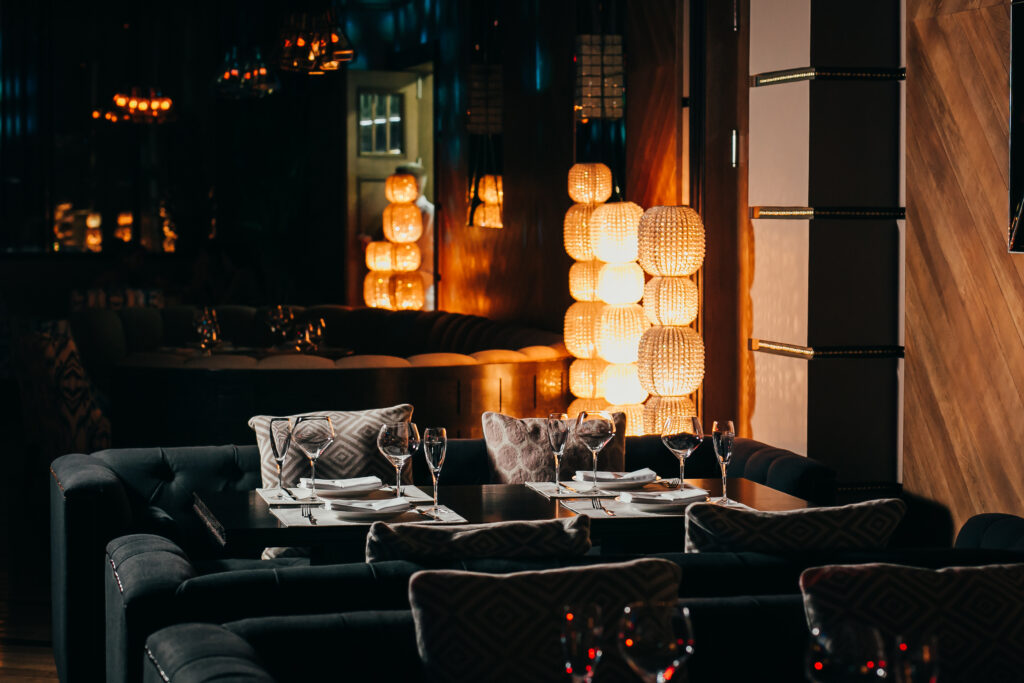Have you ever noticed how the design of your restaurant can make your food taste better or worse? How the colours, shapes, sounds, and smells of your dining environment can influence your mood, appetite, and satisfaction? How the theme, style, and atmosphere of your restaurant can attract or repel customers?
If you are curious about these questions, then you are in for a treat. In this article, we will explore how the psychology and neuroscience of food and taste are affected by restaurant design and show you how you can use it to enhance your dining experience and boost your business. We will also share some tips and best practices that can help you create a successful restaurant design.

How does Restaurant Design Affect Food and Taste?
Restaurant design affects food and taste in various ways:
- It influences the expectation and perception of the food by creating a mood, theme, or story that matches or contrasts with the food.
- It enhances or reduces the food’s flavour, texture, aroma, and appearance by using different colours, shapes, sounds, and smells in the dining environment.
- It creates different dining experiences and memories for the customers by using different styles, themes, or atmospheres in the restaurant.
Some examples of how restaurant design affects food and taste are:
- The colour red stimulates appetite and enhances the perception of sweetness and spiciness. That’s why many fast-food chains and ethnic restaurants use red in their logos, menus, or interiors
- The shape of the plate or glass can affect how much food or drink we consume and how we rate its quality. For instance, round plates can make food look more abundant and appealing than square plates. Similarly, tall glasses can make drinks look larger and more satisfying than short glasses.
- The sound of music or noise can influence our mood, arousal level, and taste preferences. For example, loud music can make us eat faster and drink more alcohol. On the other hand, soft music can make us relax and enjoy our food more. Moreover, different types of music can match or mismatch with varying types of food. For instance, classical music can enhance the taste of fine wine or cheese. Conversely, heavy metal music can clash with delicate or subtle flavours.
- The smell of food or other aromas can trigger our appetite, emotions, and memories. For example, the smell of baking bread or coffee can make us hungry and happy. On the other hand, the smell of garbage or sewage can make us lose our appetite and feel disgusted. Furthermore, the smell of food can evoke nostalgic or cultural associations. For instance, the smell of cinnamon or gingerbread can remind us of Christmas or home.

How does Restaurant Design Affect Mood?
Restaurant design affects mood in various ways:
- It influences the emotional state and attitude of the customers by creating a positive or negative impression of the restaurant.
- It enhances or reduces the comfort, satisfaction, and enjoyment of the customers by providing a cosy, spacious, or elegant setting for dining.
- It creates different social interactions and relationships among customers by facilitating or hindering communication, intimacy, or privacy.
Some examples of how restaurant design affects mood are:
- The lighting of the restaurant can affect the mood and behaviour of the customers by creating different levels of brightness, warmth, or contrast. For example, dim lighting can create a romantic, intimate, or relaxing mood. On the other hand, bright lighting can create a lively, energetic, or alert mood. Moreover, different types of lighting such as natural, artificial, or candlelight can create different effects on the ambience and perception of the food.
- The furniture and accessories of the restaurant can affect the mood and comfort of the customers by providing different levels of functionality, ergonomics, or aesthetics. For example, comfortable chairs and tables can make customers feel relaxed and welcome. On the other hand, uncomfortable or mismatched furniture can make customers feel uneasy or unwelcome. Furthermore, different types of furniture and accessories such as sofas, booths, stools, cushions, plants, or art can create different styles and atmospheres in the restaurant
- The layout and floor plan of the restaurant can affect the mood and interaction of the customers by providing different levels of space, flow, or privacy. For example, a spacious and open layout can make customers feel free and sociable. On the other hand, a cramped and crowded layout can make customers feel claustrophobic and annoyed. Moreover, different types of layouts and floor plans such as linear, circular, zigzag, or modular can create different patterns and dynamics in the restaurant.
Restaurant design is an important aspect of your food business. It affects your food and taste in various ways by influencing your expectation, perception, and experience of them. It also affects your mood in various ways by influencing your emotional state, attitude, and satisfaction with them. By learning more about restaurant design, you can enhance your food and mood experience and boost your business.
If you are looking for a professional and reliable food service consultant, you can contact HPG Consulting. HPG Consulting is an expert in food service planners, offering comprehensive consulting and planning services, covering planning, design, construction, operation, and staff training, for restaurants, hotels, clubs, corporate offices, healthcare facilities, educational institutions, and more.